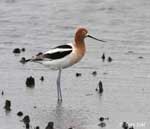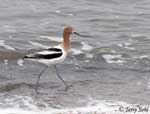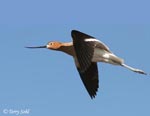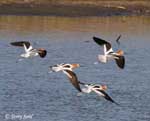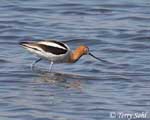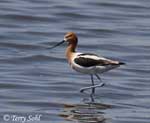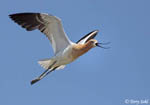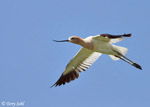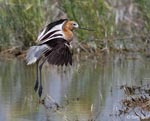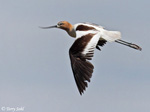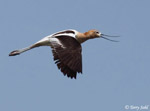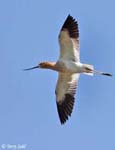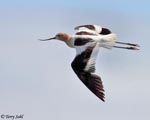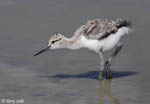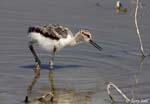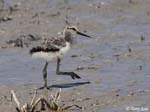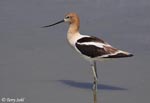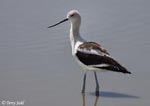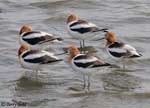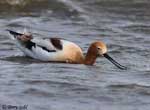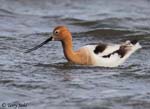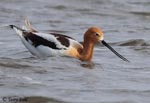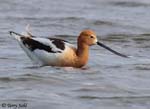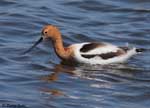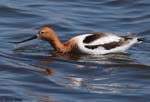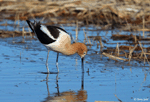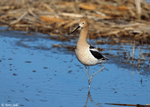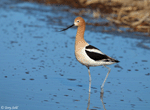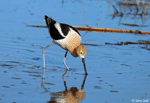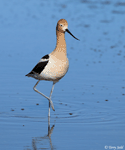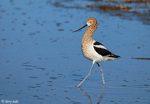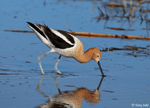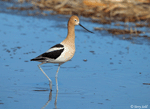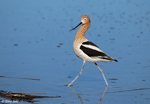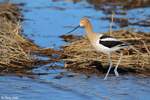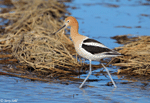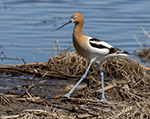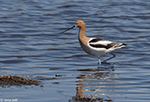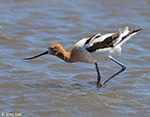| Length: 18 inches | Wingspan: 30 - 35 inches | Seasonality: Migrant / Summer |
| ID Keys: Strongly upcurved bill, black-and-white pattern on back and wings, rusty neck and head. | ||
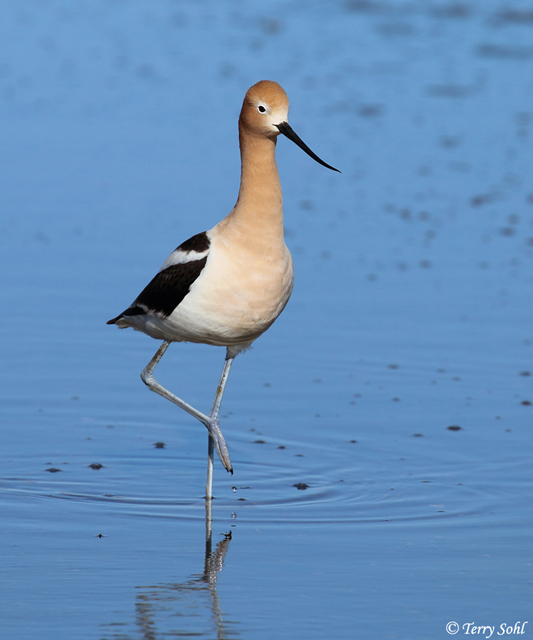 The American Avocet is often seen feeding in shallow waters, sweeping its strongly upcurved bill from
side-to-side as it feeds on aquatic insects and crustaceans. Sometimes
groups of Avocets are seen, lined up side-by-side and sweeping forward as they
search for food. American Avocets can be found as summer breeders in much of
South Dakota, although in parts of the extreme far southeastern side of the
state they are only uncommon migrants.
The American Avocet is often seen feeding in shallow waters, sweeping its strongly upcurved bill from
side-to-side as it feeds on aquatic insects and crustaceans. Sometimes
groups of Avocets are seen, lined up side-by-side and sweeping forward as they
search for food. American Avocets can be found as summer breeders in much of
South Dakota, although in parts of the extreme far southeastern side of the
state they are only uncommon migrants.
Habitat:
On their summer breeding grounds, American Avocets use shallow lakes and ponds, and mudflats. Areas chosen for breeding are usually relatively barren and devoid of vegetation or other structure. They also seem to prefer alkaline or salty inland waters over fresh water, if available. During migration and in the winter, they will use a broader array of habitats, including estuarine and other near-shore waters. They can often be seen in flooded fields during the spring migration in South Dakota.
Diet:
Mostly aquatic insects and crustaceans. On brackish or salt water areas of the western US, they are often seen feeding heavily on brine flies. They will also east small fish, and on occasion plant material.
Behavior:
Feeds by sweeping bill from side-to-side in shallow water, plucking food items from the water surface or ground, or by submerging its head for items under water. During nesting, may perform distraction displays to lure predators away from nests and nestlings, often squatting and pretending they're incubating eggs on a nest site, only to fly away and repeat the posture as a predator approaches.
Nesting:
May through July. The nest of an American Avocet is a shallow depression, typically scraped out on an open sandy or dirt area. The nest may be on a sandy shore or other lake shore, but it is often placed on an island or other area that offers some protection from predators. The nest itself is typically sparse, often consisting of nothing more than the scrape itself, but also sometimes lined with down, grasses, and bits of debris. The female lays 3 to 4 eggs, with both parents helping to incubate them. The young hatch after about 3 1/2 weeks. The young leave the nest soon after hatching and are responsible for finding their own food, but the parents are typically close by to protect them.
Interactive eBird Map:
Click to access interactive eBird map for the American Avocet
Song:
Loud pleeeeep is generally only heard as an alarm call, when American Avocets are disturbed or a predator is near. They are usually relatively silent.
1Click here to hear the alarm call of an American Avocet, recorded in Chihuahua Mexico.
Migration:
Summers throughout much of the interior central and western United States and southern Canada. Migrates in the fall to U.S. coasts, central valleys of California, Mexico, and Central America. In South Dakota they are summer breeding residents in much of the state.
Similar Species:
The overall size, shape, and plumage makes the American Avocet unlikely to be confused with another species if seen well. Superficially, the Black-necked Stilt may appear similar in shape and structure when seen at a distance, as both share impossibly long legs and a similar body shape and posture. However, the plumage differences are clear. The Black-necked Stilt also has a shorter, straight bill, while the American Avocet's is longer and upcurved.
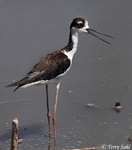 |
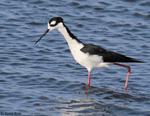 |
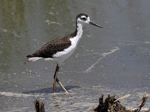 |
| Black-necked Stilt | Black-necked Stilt | Black-necked Stilt |
Conservation Status:
Over-hunting greatly reduced their numbers in the 19th century, as did the drainage and subsequent loss of wetlands and other traditional breeding grounds. However, they have rebounded strongly since the early 20th century. They are now found across a very broad geographic area, and are common in parts of their range. With overall populations stable in recent decades, the IUCN considers the American Avocet to be a species of "least concern".
Further Information:
Photo Information:
April 20th, 2019 - Weisensee Slough, western Minnehaha County, South Dakota -- Terry Sohl
Additional Photos:
Click on the image chips or text links below for additional, higher-resolution American Avocet photos.
Audio File Credits:
1Fernando Mondaca Fernandez, XC383881. Accessible at www.xeno-canto.org/383881.
| Click on the map below for a higher-resolution view |
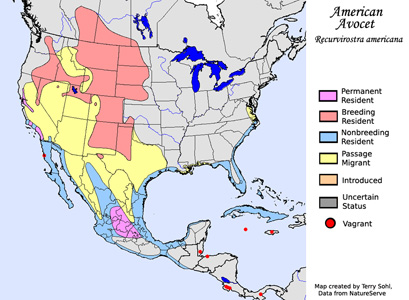 |
| South Dakota Status: Common migrant and summer breeder in most of the state, although less common in the southeastern corner of the state. |
Additional American Avocet Photos
Click for a higher-resolution version of these photos
